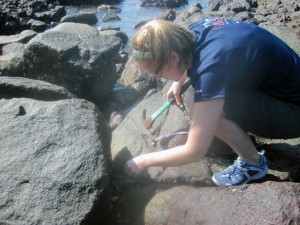by Katrina Lohan
I would love to be able to say that I am a world traveler with loads of experience visiting other countries, but that would be far from the truth. Unfortunately for me, my passport has only a few stamps. (Two to be precise, as it wasn’t stamped for walking across the border into Mexico or crossing the border to have dinner in Canada.) So traveling to Panama to collect oysters has expanded my horizons in more ways than one!In Panama, Kristy and I are working with Mark Torchin and Carmen Schloeder, scientists at the Smithsonian Tropical Research Institute in Panama. Our first sampling site was about a five-minute drive from the Smithsonian’s Naos Laboratory, which sits just outside Panama City on the Pacific Ocean.
The location, Punta Culebra, was beautiful. The tide on the Pacific side rises and falls about 18 feet throughout the day, so we went out to sample at low tide, hoping to find lots of oysters. We weren’t disappointed! We found lots of Saccostrea palmula, a small oyster species common in the intertidal zone in the eastern Pacific. We had to use screwdrivers and hammers to break the oysters off the rocks, which is particularly tricky given that breaking open the oyster shell before we get to the lab can damage the tissues that we need to collect.
While collecting, Mark pointed out the numerous large cargo ships that were lining up to come through the Panama Canal, which we could see from our sampling site. Ships from all over the world come through the Canal, as it is the easiest way to get from the Pacific to the Atlantic Ocean and vice versa. Unfortunately, some organisms in the ballast water or on the hulls of these ships are able to survive the journey and be deposited in distant locations. When these organisms survive and thrive, they can become invasive and have huge impacts on an ecosystem. Parasites are no exception to that rule, which is why sampling around the Canal is so important—it may lead to further insight into what parasites are not only present in the region, but also have the potential to be picked up and shipped around the world! But one of the downfalls of studying microscopic parasites with DNA techniques: There is no such thing as instant gratification. It may be a little while before we know what parasites are in these oysters and these waters…
Back in the lab, we had to scrounge up some supplies. An unfortunate circumstance of traveling long distances for fieldwork is that you have to ship the supplies you need, and sometimes those supplies get stuck in customs. We thought we had given our stuff plenty of time to get to Panama and make it through customs, but we were wrong. So we did the best with what we could find to improvise for our supplies and were able to collect tissue samples from the oysters we collected.
While it certainly pays off to be resourceful, I’m hopeful that our supplies arrive soon!


